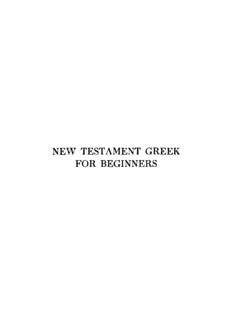Transcription of THE APOSTOLIC BIBLE
1 THEAPOSTOLIC BIBLEPOLYGLOTGREEK-ENGLISH INTERLINEARTHEAPOSTOLIC BIBLEPOLYGLOT A numerically coded Greek-English Interlinear BIBLE ,English-Greek Index, and Lexical APOSTOLIC PRESS NEWPORTA mazing Grace 1996, 2013 by Charles Van der Pool. All rights reservedPublished 1996, Second Edition 2013 Printed in the United states of AmericaSECOND EDITIONISBN 0-9632301-3-1 The APOSTOLIC Press547 NW Coast StreetNewport, Oregon BIBLE DESCRIPTION The APOSTOLIC BIBLE Polyglot consists of three major works The APOSTOLIC BIBLE literal interlinear translation of the Greek Old and New Testaments, The Lexical Concor-dance of The APOSTOLIC BIBLE , and The English-Greek Index of The APOSTOLIC BIBLE . *See Note on the Second Edition. These three works are numerically coded with the AB-Strong numbering GREEK SCRIPTURES The Greek Old testament , commonly referred to as the Septuagint or LXX, was translated from the He-brew Scriptures approximately 250 years before the Christ.
2 An account of this occurrence is noted in the dubious Letter of Aristeas, and can be found in the back of An Introduction to The Old testament in Greek, by Henry Barclay Swete, 1902. Whether or not this letter is true to the facts can be debated, but that the Greek Scrip-tures were well entrenched by the time of the birth of the Christ is undeniable. The acceptance of the Greek Scriptures can best be described by a quotation in the Mishna written around the time of the Christ, with Herbert Danby s transla-tion reading in Megillah , "The Books [of Scrip-ture] differ from phylacteries and Mezuzahs only in that the Books may be written in any language, while phylacteries and Mezuzahs may be written in the Assyr-ian writing only. Rabban Simeon b. Gamaliel says: 'The Books, too, they have only permitted to be written in Greek.' At the time the new testament was being written, the language of the common people of the Holy Land was Aramaic, but Greek was the international language used throughout the Mediterranean world.
3 The sign above the head of the suffering Christ was written in Hebrew, Greek and Latin, with Latin being the tongue used by the Roman military, prelates, and judiciary. The Hellenists in Jerusalem at the time of the Passion were Greek speaking Jews, and some became Christians as related in Acts 11:20. Also in Acts 21:37 Paul asked the commander, Is it allowed for me to speak to you? The commander responded, You know Greek? When the apostles wrote the Sacred Scriptures to various churches and peoples, the common written form was Greek, as most of the Jews of the Diaspora understood Greek, and lived in areas where Greek was spoken. It was common for the writers of the New Tes-tament, when need arose to quote the Old testament , to quote the Greek Scriptures rather than the Hebrew Scriptures. With the incorporation of the Greek Old testament Scriptures into the Greek new testament via quotes, surely this puts the Greek Old testament in a unique position, as these Greek Old testament words have become engrafted into the Divine Word of the new testament .
4 For hundreds of years after the Christ, during the formation of the APOSTOLIC age, the Greek Scriptures were consistently read and quoted by the Church Fathers. These all-Greek Scriptures are still in use in Eastern Christendom today, although the Canon is different. The APOSTOLIC BIBLE continues this tradi-tion of The APOSTOLIC Age Greek Scriptures, and is thus named The APOSTOLIC BIBLE . With the fact of the Greek Old testament partly being grafted into the "inspired Greek New Testa- ment , it is inconceivable to think one can truly under-stand the deep meanings of the Greek new testament without having the knowledge of the Greek Old Testa- ment . For example, consider the following passage in the King James BIBLE , "he hath made him to be sin for " 2 Corinthians 5:21. The word for sin is #266 , where in Numbers 6:14, and many other places in the Greek Old testament , the word, is translated "sin offering.
5 " Offering de-noted by the Italics, is implied by the context, as it was talking of animals for a sacrifice for sin. Jesus becom-ing the sin offering opens a whole new aspect of under-standing this verse. That the Greek Scriptures were designed for the Church is a strong argument, but this is not meant to demean the Hebrew Scriptures of the autographs. Seeing that God saw fit to communicate mainly through the written Word, it is to one s advan-tage to search diligently both the Hebrew and Greek The books of The APOSTOLIC BIBLE correspond to the Hebrew Canon and the current Authorized Version, as vINTRODUCTIONfar as book order and names. The most notable differ-ence in book names are 1,2 Samuel, and 1,2 Kings, which in the Orthodox canon are named 1,2,3,4 Kings. The Orthodox Canon, along with the Roman Canon also contains books which do not appear in the Hebrew Canon, nor the current Authorized Version of the English BIBLE , such as the books of Baruch and Maccabees, commonly called the Apocrypha.
6 The APOSTOLIC BIBLE follows the book order of the current Authorized Version of the English BIBLE . It must be noted that many other book arrangements have ap-peared in various BIBLE manuscripts and printed edi-tions over the centuries. For example, Tyndale s new testament follows a different book order than the Authorized Version, and has the Book of Hebrews fol-lowing 3 John. The development of the Holy Scrip-tures of the early church readily adhered to the all-Greek Scriptures of both Old and New Testaments, rather than a Hebrew Old testament -Greek New Tes-tament structure which is prevalent today in the Eng-lish BIBLE . This all-Greek mode was the norm in West-ern Churches for hundreds of years during the devel-opment of the Latin, Syriac and Coptic Scriptures. The Greek Fathers, Clement, Eusebius, and many oth-ers, all writing in Greek, quoted the Greek Old and New Testaments BIBLE GREEK TEXT The APOSTOLIC BIBLE was not begun with the thought of a new BIBLE translation, but was the result of years of private studies that evolved into The APOSTOLIC BIBLE .
7 The original typed text followed the Vaticanus-Sixtine text family. Then with the acquisition of the 1519 Aldine BIBLE in microfilm format from the Kon-inklijke Bibliotheek, of the Netherlands, a comparison was made between the Sixtine and Aldine texts, where one reading was chosen over the other. With the acqui-sition of the 1709 edition of the Greek Old testament , edited by Lambert Bos, the 1518 Complutensian Poly-glot variants, located in the extensive footnote sections, were added for comparison with the Sixtine and Aldine texts. With further comparison it was decided to choose mainly the text where two printed editions agreed. But since that time the acquisition of a full set of the Complutensian Polyglot BIBLE in facsimile for-mat enabled a closer comparison to be made, not only of variant readings, but also chapter and verse varia-tions, along with punctuation.
8 As various manuscripts become available, these will also be compared with the text of The APOSTOLIC BIBLE , and changes may be made. The Vatopedi manuscript, available from the Library of Congress in microfilm form, is one such manuscript among many that will be used for BIBLE STRUCTURE The history of interlinear Bibles goes back into the manuscript age where interlinear Bibles appear with various language combinations. For example, the ninth century Codex Boernerianus displays the Greek text of the Pauline Epistles with the Latin appearing above every Greek word. The earliest printed Greek BIBLE , the Complutensian Polyglot, has an interlinear Greek-Latin text for the Old testament , with the He-brew Scriptures being in a separate column. Given the introduction of the numbering system of James Strong, interlinear Bibles took on a three line format with the Strong s number appearing above the Greek and He-brew texts, and the English below.
9 The APOSTOLIC BIBLE is the first numerically coded Greek Old testament , and it allows the student of the Word to study both Testaments in the same language, and to follow the association of a word from either the new testament to the Old testament , or vice versa. The APOSTOLIC BIBLE trilinear format has the AB-Strong numbers on the top line, the Greek text on the middle line, and the English translation on the bottom line. The APOSTOLIC BIBLE text is separated into books, chap-ters, section headings, verses, and Numbering System In 1890, James Strong developed his monumental work, The Exhaustive Concordance of the BIBLE , containing every English word of the Authorized Version, com-monly called the King James Version. Included in this monumental work are two companion dictionaries of the Hebrew and Greek Scriptures. The first dictionary viis, A Concise Dictionary of the Words in the Hebrew BIBLE , nu-merically coded, containing 8674 Hebrew words with English definitions corresponding to the Exhaustive Concordance.
10 The second dictionary is, A Concise Dic-tionary of the Words in the Greek testament , numerically coded, containing 5624 Greek words with English definitions corresponding to the Exhaustive Concordance. As the English Authorized Version is based on the Hebrew Old testament and Greek new testament , a problem arose when it was decided to numerically code the Greek Old testament , which had not been coded by James Strong. It was decided to adapt the Strong s new testament Greek Dictionary numbering system to The APOSTOLIC BIBLE , and to furnish numbers for the Greek Old testament words that were not included in Strong s Greek Dictionary of the new testament , by alphabetically inserting new numbers delineated by decimal points between the existing Strong s New Tes-tament Greek words. Hence, a word with an AB-Strong number with a decimal point generally means that that word appears only in the Greek Old Testa- ment .


